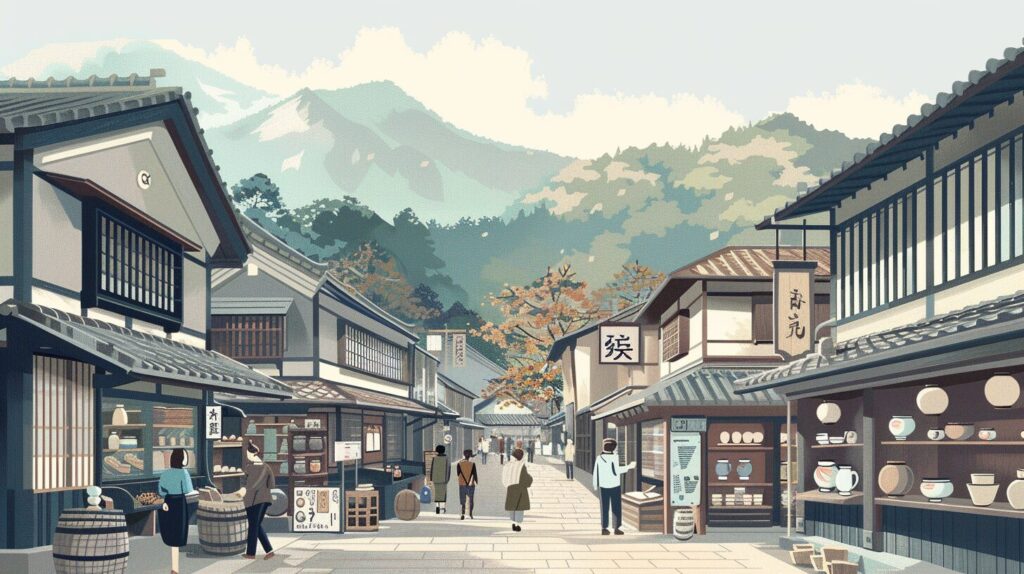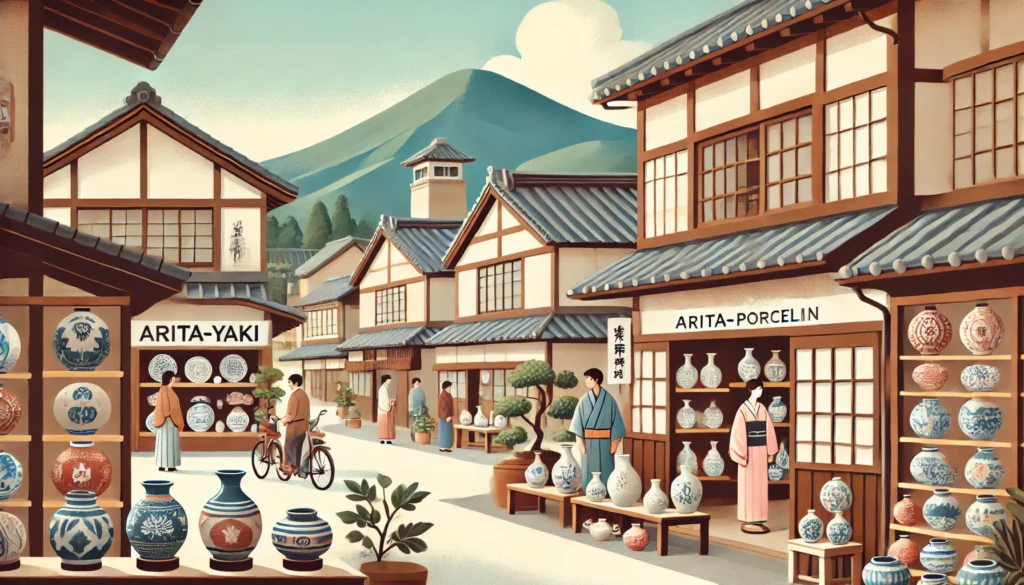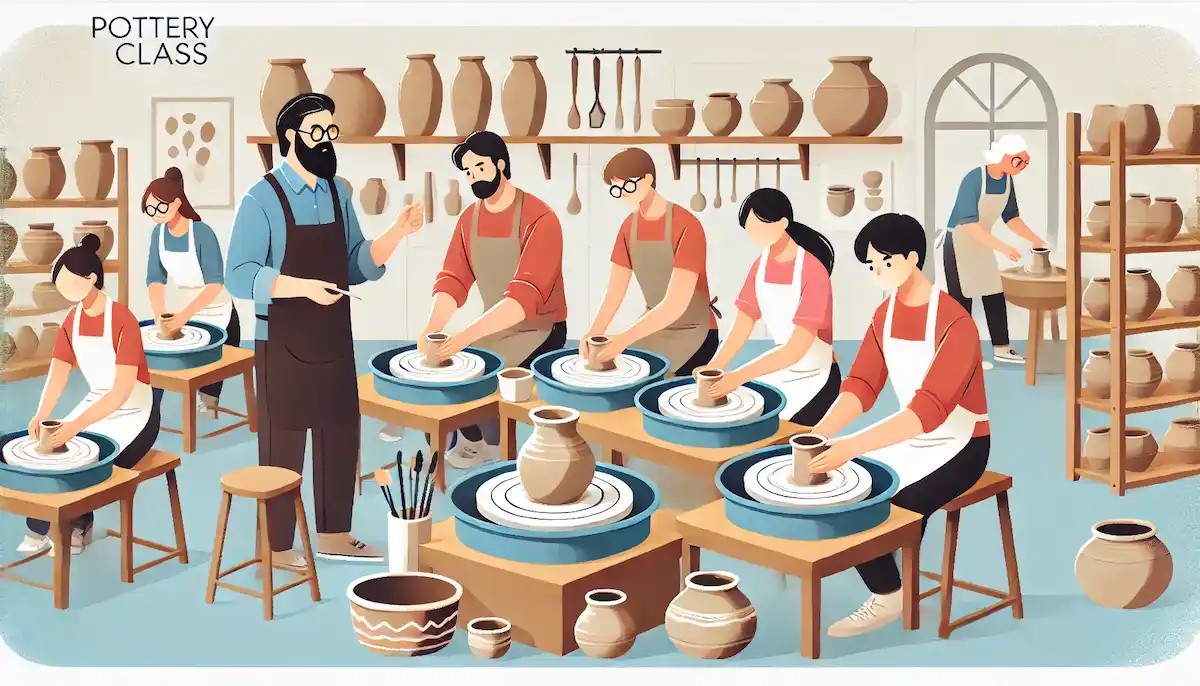有田焼を英語で説明・紹介するための基本情報と、英会話に役立つ表現をシンプルでわかりやすい英語で紹介します。
英会話ダイアローグ・関連情報・10の質問を通して、有田焼に関する英語表現を学びます。
英語
英会話ダイアローグを読む前に知っておくと良い前提知識と情報です。
- 有田焼とは:
- 日本で最初に作られた磁器
- 17世紀初頭に佐賀県有田で誕生
- 韓国から来た陶工・李参平が始祖
- デザインの特徴:
- 色彩豊かで繊細な模様が特徴
- 染付:白磁に青色で絵付けする技法
- 色絵:多彩な色を使用する技法
- 国際的な評価:
- 17世紀後半からヨーロッパに輸出
- 「伊万里焼」の名で知られ、高級品として扱われる
- 現代の有田焼:
- 伝統技法を守りつつ、現代的なデザインも取り入れている
- 日用品から芸術作品まで幅広く製作されている
- 観光情報:
- 有田町では陶磁器に関する見学ツアーや体験プログラムがある
2人が有田焼について話しています。
有田焼の歴史や特徴、デザインの種類、国際的な評価、実用性や文化的価値などを話題にしています。
会話 / dialogue

Key, I’ve been really interested in Arita-yaki lately. Have you heard of it?

Yeah, I know Arita-yaki! It’s a type of porcelain, right? What got you into it?

I saw some Arita-yaki dishes in a shop recently. The designs were so beautiful—really delicate and colorful. I wanted to learn more about it.

That’s great! Did you know it’s Japan’s first porcelain? It started over 400 years ago, in the 17th century, in Arita, Saga Prefecture.

Wow, I didn’t realize it had such a long history. How did it all start?

It began when a Korean potter, Ri Sampei, discovered kaolin, which is the clay needed for porcelain, in Arita. That’s when they started making Arita-yaki.

So that’s why it’s so special. The patterns, like the blue and white designs—what’s that called again?

That’s called “sometsuke,” the blue and white style. There’s also “akae,” which uses bright red and sometimes gold. The attention to detail is amazing, isn’t it?

Yeah, it’s almost like art, but you can actually use it in daily life. That balance between practicality and beauty really appeals to me.

Exactly. That’s one of the reasons Arita-yaki became so popular, not just in Japan but also internationally. It was even exported to Europe in the 17th and 18th centuries.

I’ve heard about that! They called it “Imari ware” because it was shipped from Imari Port. It must have been a hit back then.

Definitely. European royalty and aristocrats loved it. It was highly prized for its quality and beauty.

It’s still popular today, right? I’ve seen some modern designs that look more contemporary but still have that traditional feel.

Yes, Arita-yaki continues to evolve. There are collaborations with modern artists, so you can find pieces that fit today’s lifestyle while maintaining the traditional craftsmanship.

That’s really cool. I’m thinking of getting a set for my home. Do you think it’s practical for everyday use?

Absolutely. Arita-yaki is known for being strong and durable, despite how thin and delicate it looks. You can use it daily without worrying about it breaking easily.

That’s good to know. I was worried it might be too fragile. The fact that it’s practical makes it even more appealing.

For sure. Plus, it has a rich cultural value. Owning Arita-yaki feels like owning a piece of Japanese history.

I love that idea. It’s amazing how something so old can still be relevant today. I really want to learn more about the different designs and how they’re made.

You should visit Arita! They have pottery tours where you can see the process firsthand and even try making your own piece.

That sounds like a great experience. I’ll definitely plan a trip there soon. It would be fascinating to see how the artisans work.

I think you’d love it. Arita-yaki is not just about the porcelain—it’s about the craftsmanship, the history, and the beauty that has lasted for centuries.

Yeah, I’m really starting to appreciate it more. I can’t wait to explore it further.
関連情報 / related information
「有田焼」について、理解を深めるための「英語での関連情報」です。
有田焼

History of Arita-yaki
Arita-yaki is a type of Japanese porcelain that began in the early 17th century. It was first made in Arita, a town in Saga Prefecture. A Korean potter named Ri Sampei discovered a type of clay called kaolin in Arita, which is essential for making porcelain. This discovery allowed Japan to produce porcelain for the first time. Arita-yaki has over 400 years of history and is still made today.
Designs and Features
Arita-yaki is known for its beautiful and detailed designs. There are two famous styles: “sometsuke,” which uses blue and white patterns, and “akae,” which uses bright red and sometimes gold. The designs are very intricate, making Arita-yaki not only practical for daily use but also a work of art.
International Popularity
Arita-yaki became popular in Europe during the Edo period. It was exported through Imari Port, so it was called “Imari ware” in the West. European royalty and aristocrats admired its beauty and high quality. Today, Arita-yaki is still loved worldwide for its blend of tradition and modern design.
10の質問 / 10 questions
「有田焼」について、理解を深めるための「英語での10の質問」です。
1: What is Arita-yaki?
Arita-yaki is a type of Japanese porcelain that was first made in Arita, Saga Prefecture, over 400 years ago. It is known for its high quality and beautiful designs.
2: Who discovered the method to make Arita-yaki?
A Korean potter named Ri Sampei discovered the method to make Arita-yaki after finding kaolin, a special clay used for making porcelain, in Arita.
3: What are the main styles of Arita-yaki?
The main styles of Arita-yaki are “sometsuke,” which uses blue and white patterns, and “akae,” which features bright red and sometimes gold designs.
4: Why is Arita-yaki called “Imari ware” in the West?
Arita-yaki is called “Imari ware” in the West because it was exported from Imari Port during the Edo period, and the name “Imari” became well-known internationally.
5: Is Arita-yaki used only for decoration?
No, Arita-yaki is practical for daily use as tableware, but it is also considered a work of art because of its detailed and beautiful designs.
6: Why did Arita-yaki become popular in Europe?
Arita-yaki became popular in Europe because of its high quality and intricate designs, which were admired by European royalty and aristocrats.
7: How long has Arita-yaki been made?
Arita-yaki has been made for over 400 years, starting in the early 17th century.
8: What materials are used to make Arita-yaki?
Arita-yaki is made from kaolin, a special type of clay that is used to produce porcelain. This clay gives Arita-yaki its strength and smooth texture.
9: Can you still buy Arita-yaki today?
Yes, Arita-yaki is still produced today, and you can buy both traditional designs and modern versions that fit contemporary lifestyles.
10: What makes Arita-yaki unique?
Arita-yaki is unique because of its combination of traditional craftsmanship, intricate designs, and its long history of over 400 years. It continues to evolve with modern styles while preserving its heritage.

和訳付
会話 / dialogue

Key, I’ve been really interested in Arita-yaki lately. Have you heard of it?
キー、最近、有田焼にすごく興味があるんだ。知ってる?

Yeah, I know Arita-yaki! It’s a type of porcelain, right? What got you into it?
うん、有田焼知ってるよ!磁器の一種だよね?どうして興味を持ったの?

I saw some Arita-yaki dishes in a shop recently. The designs were so beautiful—really delicate and colorful. I wanted to learn more about it.
最近、お店で有田焼の食器を見たんだ。デザインがすごく美しくて、繊細でカラフルだったから、もっと知りたくなったんだよ。

That’s great! Did you know it’s Japan’s first porcelain? It started over 400 years ago, in the 17th century, in Arita, Saga Prefecture.
それはいいね!有田焼って、日本初の磁器だって知ってた?400年以上前、17世紀に佐賀県の有田で始まったんだよ。

Wow, I didn’t realize it had such a long history. How did it all start?
すごい、そんなに長い歴史があるなんて知らなかった。どうやって始まったの?

It began when a Korean potter, Ri Sampei, discovered kaolin, which is the clay needed for porcelain, in Arita. That’s when they started making Arita-yaki.
韓国の陶工、李参平(りさんぺい)が有田でカオリンっていう磁器に必要な土を発見したのがきっかけなんだよ。そこから有田焼が作られ始めたんだ。

So that’s why it’s so special. The patterns, like the blue and white designs—what’s that called again?
だから特別なんだね。青と白のデザインとか、あれは何て言うんだっけ?

That’s called “sometsuke,” the blue and white style. There’s also “akae,” which uses bright red and sometimes gold. The attention to detail is amazing, isn’t it?
それは「染付」って言うんだよ、青と白のスタイルね。他には「赤絵」っていう鮮やかな赤と、時には金を使うデザインもあるよ。細かいところまで本当に素晴らしいよね。

Yeah, it’s almost like art, but you can actually use it in daily life. That balance between practicality and beauty really appeals to me.
うん、ほとんどアートみたいだけど、日常で使えるんだよね。その実用性と美しさのバランスがすごく惹かれるんだ。

Exactly. That’s one of the reasons Arita-yaki became so popular, not just in Japan but also internationally. It was even exported to Europe in the 17th and 18th centuries.
まさにその通り。それが有田焼が日本だけじゃなくて、国際的にも人気になった理由の一つだよ。17世紀と18世紀にはヨーロッパにも輸出されてたんだ。

I’ve heard about that! They called it “Imari ware” because it was shipped from Imari Port. It must have been a hit back then.
それ聞いたことあるよ!伊万里港から出荷されてたから「伊万里焼」って呼ばれてたんだよね。当時は大人気だったんだろうね。

Definitely. European royalty and aristocrats loved it. It was highly prized for its quality and beauty.
間違いないよ。ヨーロッパの王族や貴族たちがすごく気に入ってたんだ。品質と美しさがとても評価されてたんだよ。

It’s still popular today, right? I’ve seen some modern designs that look more contemporary but still have that traditional feel.
今でも人気だよね?最近、現代風のデザインも見たけど、伝統的な感じが残ってるのがいいな。

Yes, Arita-yaki continues to evolve. There are collaborations with modern artists, so you can find pieces that fit today’s lifestyle while maintaining the traditional craftsmanship.
そうだね、有田焼は進化し続けてるよ。現代のアーティストとのコラボレーションもあって、伝統の技術を保ちながら、今のライフスタイルに合った作品もあるよ。

That’s really cool. I’m thinking of getting a set for my home. Do you think it’s practical for everyday use?
それすごくいいね。自分の家にセットで買おうと思ってるんだけど、日常使いにも実用的だと思う?

Absolutely. Arita-yaki is known for being strong and durable, despite how thin and delicate it looks. You can use it daily without worrying about it breaking easily.
もちろんだよ。有田焼は薄くて繊細に見えるけど、実は丈夫で壊れにくいことで有名なんだ。だから毎日使っても全然問題ないよ。

That’s good to know. I was worried it might be too fragile. The fact that it’s practical makes it even more appealing.
それを聞いて安心したよ。壊れやすいんじゃないかって心配だったんだ。実用的っていうのも、さらに魅力的だね。

For sure. Plus, it has a rich cultural value. Owning Arita-yaki feels like owning a piece of Japanese history.
間違いないよ。それに文化的な価値もすごく高いんだ。有田焼を持つことは、日本の歴史の一部を持つような感じだよね。

I love that idea. It’s amazing how something so old can still be relevant today. I really want to learn more about the different designs and how they’re made.
その考え、すごくいいね。こんなに古いものが今でも通用するって、本当にすごいよね。もっといろんなデザインや作り方について知りたくなってきたよ。

You should visit Arita! They have pottery tours where you can see the process firsthand and even try making your own piece.
それなら有田に行くべきだよ!陶器のツアーがあって、製作過程を直接見られるし、自分で作る体験もできるよ。

That sounds like a great experience. I’ll definitely plan a trip there soon. It would be fascinating to see how the artisans work.
それは素晴らしい体験になりそうだね。すぐにでも旅行を計画するよ。職人さんたちがどうやって作業しているのか見るのは面白そうだ。

I think you’d love it. Arita-yaki is not just about the porcelain—it’s about the craftsmanship, the history, and the beauty that has lasted for centuries.
きっと気に入ると思うよ。有田焼はただの磁器じゃなくて、職人技や歴史、そして何世紀も続く美しさが詰まっているんだ。

Yeah, I’m really starting to appreciate it more. I can’t wait to explore it further.
そうだね、ますますその価値が分かってきたよ。もっと深く探求するのが楽しみだよ。
関連情報 / related information
有田焼

History of Arita-yaki
Arita-yaki is a type of Japanese porcelain that began in the early 17th century. It was first made in Arita, a town in Saga Prefecture. A Korean potter named Ri Sampei discovered a type of clay called kaolin in Arita, which is essential for making porcelain. This discovery allowed Japan to produce porcelain for the first time. Arita-yaki has over 400 years of history and is still made today.
有田焼は17世紀初頭に始まった日本の磁器の一種です。最初は佐賀県の有田町で作られました。韓国の陶工である李参平が有田でカオリンという磁器作りに必要な粘土を発見しました。この発見によって、日本で初めて磁器が作られるようになりました。有田焼は400年以上の歴史を持ち、今でも作られ続けています。
Designs and Features
Arita-yaki is known for its beautiful and detailed designs. There are two famous styles: “sometsuke,” which uses blue and white patterns, and “akae,” which uses bright red and sometimes gold. The designs are very intricate, making Arita-yaki not only practical for daily use but also a work of art.
有田焼は美しく繊細なデザインで知られています。有名なスタイルには2つあり、青と白の模様を使う「染付」と、鮮やかな赤や時には金を使う「赤絵」があります。デザインは非常に細かく描かれており、有田焼は日常使いにも適しているだけでなく、芸術作品としても評価されています。
International Popularity
Arita-yaki became popular in Europe during the Edo period. It was exported through Imari Port, so it was called “Imari ware” in the West. European royalty and aristocrats admired its beauty and high quality. Today, Arita-yaki is still loved worldwide for its blend of tradition and modern design.
有田焼は江戸時代にヨーロッパで人気が出ました。伊万里港から輸出されていたため、西洋では「伊万里焼」として知られていました。ヨーロッパの王族や貴族たちは、その美しさと高い品質を称賛しました。今日でも、有田焼は伝統と現代デザインの融合で世界中で愛されています。
10の質問 / 10 questions
1: What is Arita-yaki?
有田焼とは何ですか?
Arita-yaki is a type of Japanese porcelain that was first made in Arita, Saga Prefecture, over 400 years ago. It is known for its high quality and beautiful designs.
有田焼は、400年以上前に佐賀県有田で作られ始めた日本の磁器の一種です。その高品質と美しいデザインで知られています。
2: Who discovered the method to make Arita-yaki?
有田焼の製法を発見したのは誰ですか?
A Korean potter named Ri Sampei discovered the method to make Arita-yaki after finding kaolin, a special clay used for making porcelain, in Arita.
韓国の陶工である李参平が、有田で磁器作りに使う特別な粘土であるカオリンを発見し、有田焼の製法を確立しました。
3: What are the main styles of Arita-yaki?
有田焼の主なスタイルは何ですか?
The main styles of Arita-yaki are “sometsuke,” which uses blue and white patterns, and “akae,” which features bright red and sometimes gold designs.
有田焼の主なスタイルには、青と白の模様を使った「染付」と、鮮やかな赤や時には金を使ったデザインの「赤絵」があります。
4: Why is Arita-yaki called “Imari ware” in the West?
なぜ有田焼は西洋で「伊万里焼」と呼ばれているのですか?
Arita-yaki is called “Imari ware” in the West because it was exported from Imari Port during the Edo period, and the name “Imari” became well-known internationally.
有田焼は江戸時代に伊万里港から輸出されていたため、「伊万里」という名前が国際的に広く知られるようになりました。
5: Is Arita-yaki used only for decoration?
有田焼は装飾品としてだけ使われるのですか?
No, Arita-yaki is practical for daily use as tableware, but it is also considered a work of art because of its detailed and beautiful designs.
いいえ、有田焼は日常の食器としても実用的ですが、その繊細で美しいデザインから芸術作品としても評価されています。
6: Why did Arita-yaki become popular in Europe?
なぜ有田焼はヨーロッパで人気になったのですか?
Arita-yaki became popular in Europe because of its high quality and intricate designs, which were admired by European royalty and aristocrats.
有田焼はその高品質と複雑なデザインがヨーロッパの王族や貴族たちに称賛され、人気を得ました。
7: How long has Arita-yaki been made?
有田焼はどれくらいの間作られていますか?
Arita-yaki has been made for over 400 years, starting in the early 17th century.
有田焼は17世紀初頭から400年以上作られ続けています。
8: What materials are used to make Arita-yaki?
有田焼を作るのに使われる材料は何ですか?
Arita-yaki is made from kaolin, a special type of clay that is used to produce porcelain. This clay gives Arita-yaki its strength and smooth texture.
有田焼はカオリンという特別な粘土から作られています。この粘土が有田焼の強度と滑らかな質感を生み出します。
9: Can you still buy Arita-yaki today?
今でも有田焼は購入できますか?
Yes, Arita-yaki is still produced today, and you can buy both traditional designs and modern versions that fit contemporary lifestyles.
はい、有田焼は今でも生産されており、伝統的なデザインと現代のライフスタイルに合うモダンなバージョンの両方を購入できます。
10: What makes Arita-yaki unique?
有田焼が特別な理由は何ですか?
Arita-yaki is unique because of its combination of traditional craftsmanship, intricate designs, and its long history of over 400 years. It continues to evolve with modern styles while preserving its heritage.
有田焼は、伝統的な職人技、複雑なデザイン、そして400年以上の長い歴史の組み合わせが特別です。伝統を守りながらも、現代のスタイルで進化し続けています。

words & phrases
英会話ダイアローグと関連情報に出てきた単語・フレーズです(例文は各3つ)。

porcelain : 名詞
意味: 磁器。A fine, white ceramic material that is made by heating special clays to high temperatures.
(有田焼は日本初の磁器であり、その美しいデザインが特徴的)
例文:
- The museum has a collection of fine porcelain from China.
「博物館には中国からの素晴らしい磁器のコレクションがあります。」 - She bought a porcelain vase at the antique store.
「彼女はアンティーク店で磁器の花瓶を買いました。」 - Porcelain is often used for high-quality tableware.
「磁器は高品質な食器に使われることが多いです。」
practicality : 名詞
意味: 実用性。The quality of being useful or sensible in real situations.
(有田焼はその実用性と芸術性のバランスが取れている)
例文:
- The practicality of this design makes it easy to use every day.
「このデザインの実用性のおかげで、毎日使うのが簡単です。」 - We need to consider the practicality of this plan before moving forward.
「この計画の実用性を考慮する必要があります。」 - She likes furniture that combines style with practicality.
「彼女はスタイルと実用性を兼ね備えた家具が好きです。」
ware : 名詞
意味: ~用品、器。Articles of the same general kind, especially ones made of a specific material or for a particular use.
(「Imari ware」という呼び方で、有田焼が西洋で広まった)
例文:
- The shop sells kitchen ware and home goods.
「その店では台所用品や家庭用品を販売しています。」 - She collects antique ware from different regions.
「彼女はさまざまな地域からのアンティーク品を集めています。」 - The company specializes in glass ware.
「その会社はガラス製品を専門にしています。」
durable : 形容詞
意味: 丈夫な、耐久性がある。Able to withstand wear, pressure, or damage; long-lasting.
(有田焼は薄く見えるが、非常に丈夫)
例文:
- This jacket is made of a durable material that lasts for years.
「このジャケットは何年も使える丈夫な素材で作られています。」 - We need to buy durable furniture for the outdoor space.
「屋外スペースのために、丈夫な家具を買う必要があります。」 - The company is known for producing durable electronics.
「その会社は耐久性のある電子製品を作ることで知られています。」
fragile : 形容詞
意味: 壊れやすい、繊細な。Easily broken, damaged, or destroyed.
(有田焼は繊細なデザインだが、意外にも丈夫で壊れにくい)
例文:
- Be careful with that fragile vase; it could break easily.
「その壊れやすい花瓶には注意してね。簡単に割れちゃうから。」 - The box contains fragile items, so handle it with care.
「この箱には壊れやすい物が入っているので、慎重に扱ってください。」 - Her health is still fragile after the surgery.
「手術の後、彼女の健康はまだ繊細な状態です。」
詳細情報 / Further Info
関連記事(陶芸)

